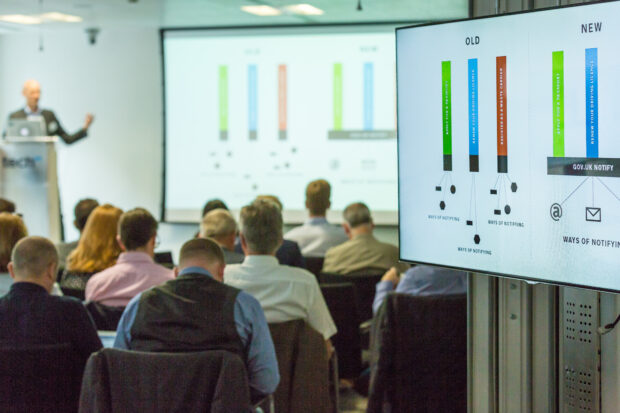
GDS is focused on increasingly supporting departments and agencies. One of the services we offer government is a set of well-researched components that meet common needs. These Government as a Platform (GaaP) components, tools, and guidance (all set out here in the service toolkit), make it faster to assemble and cheaper to run services at pace and at scale.
Building and strengthening our common components and shared platforms is at the heart of what we do.
Over the last few months we’ve seen the number of government services adopting GaaP components almost double, increasing from to 44 to 87.
We’re already seeing the impact our components are having in helping transform government services. Her Majesty’s Passport Office are sending millions of messages to users updating them on passport renewals and we recently blogged about how the Environment Agency is using Notify to issue up to 40,000 fishing licences a day.
At the same time, with GOV.UK Notify and the Digital Marketplace moving to the GOV.UK Platform as a Service (PaaS), the GaaP ecosystem is making things easier for us here at GDS too.
And we held an open invitation market briefing at TechUK to explain how Government as a Platform fits in - and the new commercial opportunities that are likely to arise as a result.
Here’s more detail about our work since we last blogged in March.
GOV.UK Pay
Since our last update, the GOV.UK Pay team have:
- improved disaster recovery and backup arrangements, and changing how we capture card payments to improve reliability
- progressed work on auto scaling groups which will, amongst other things, enable it to automatically apply security updates
- upgraded to the new Notify client
- introduced a simple step-by-step guide to going live with GOV.UK Pay
- published the GOV.UK Pay roadmap
GOV.UK Notify
The GOV.UK Notify team have:
- sent its first letters, with the Land Registry being the first service ever to send letters through GOV.UK Notify
- continued work on building international SMS capability for GOV.UK and have successfully sent messages to Canada, China and Product Manager Pete’s mum in New Zealand
- onboarded 36 more services since the last GaaP update, bringing the total up to 68 live services
- moved GOV.UK Notify onto the GOV.UK PaaS in 25 minutes and with no downtime for our API
- introduced 2-way text messages (we’ll blog about this soon)
GOV.UK Platform as a Service (PaaS)
The PaaS team have:
- enabled services to restore database snapshots
- added some content delivery network (CDN) features, so tenants can now use their own custom domains for apps hosted on the PaaS
- enabled ‘experimental’ support for users deploying an application from a public docker image. At the moment users can try this out, rather than use it in real services
- onboarded Digital Marketplace and DIT Horizon
- made cloud-based continuous integration (CI) tools (such as Travis), work with the PaaS which makes it easier to link the PaaS to GitHub (instructions here)
- enabled VPC peering so services outside the platform can be integrated
- published the PaaS roadmap
- made Mongo DB and MySQL available as backing services in beta
Registers
The Registers team have:
- have passed their alpha assessment of the registers platform
- created the ‘suggest a register’ form
- moved 6 registers from alpha to beta (government organisation, government service, local authorities Scotland, Welsh principal local authorities, prison estate and registration districts
- created three new alpha registers - industrial classifications, occupations, and registered social housing providers (we’re collecting feedback on these registers)
- published our roadmap for the next six months
- surveyed our users (ie service and product teams) about what registers they need
GOV.UK Verify
The GOV.UK Verify team have:
- reached more than 1.35m accounts
- seen accounts used over 3.5m times to access government services
- continued their work to introduce more flexibility for citizens and services with new options for services that need less proof of identity
- had two local government pilots go into beta since March 2017
- continued their work with the private sector and departments to connect more services
And, finally
For a full breakdown of what our products do, who they’re being used by, and how they’ll help service teams, you can visit the service toolkit for more information.
We work in an agile, iterative way, in which feedback plays an important part in the development of our products. These posts are designed to update you on our progress, but we’re open to feedback. If you have any comments for the team on any of our products, or on how best to provide these updates, post a comment below or contact us directly.
Follow Peter on Twitter and don’t forget to sign up for email alerts from this blog.